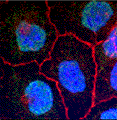Biochemistry, Department of
Document Type
Article
Date of this Version
2016
Citation
Journal of Biological Chemistry, Volume 291 Number 29 July 2016
Abstract
Endoplasmic reticulum-associated degradation (ERAD) plays a critical role in the destruction of terminally misfolded proteins at the secretory pathway. The system also regulates expression levels of several proteins such as Pca1p, a cadmium exporter in yeast. To gain better insight into the mechanisms underlying ERAD of Pca1p and other polytopic proteins by the proteasome in the cytosol, our study determined the roles for the molecular factors of ERAD in dislodging Pca1p from the endoplasmic reticulum (ER). Inactivation of the 20S proteasome leads to accumulation of ubiquitinated Pca1p in the ER membrane, suggesting a role for the proteasome in extraction of Pca1p from the ER. Pca1p formed a complex with the proteasome at the membrane in a Doa10p E3 ligase-dependent manner. Cdc48p is required for recruiting the proteasome to Pca1p. Although the Ufd2p E4 ubiquitin chain extension enzyme is involved in efficient degradation of Pca1p, Ufd2p-deficient cells did not affect the formation of a complex between Pca1p and the proteasome. Two other polytopic membrane proteins undergoing ERAD, Ste6*p and Hmg2p, also displayed the same outcomes observed for Pca1p. However, poly-ubiquitinated Cpy1*p, a luminal ERAD substrate, was detected in the cytosol independent of proteolytic activities of the proteasome. These results indicate that extraction and degradation of polytopic membrane proteins at the ER is a coupled event. This mechanism would relieve the cost of exposed hydrophobic domains in the cytosol during ERAD.
Included in
Biochemistry Commons, Biotechnology Commons, Other Biochemistry, Biophysics, and Structural Biology Commons



Comments
Copyright 2016 the authors.